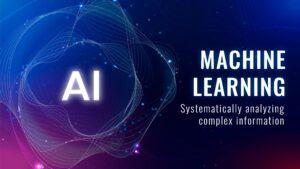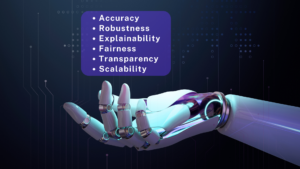








































Within the span of as it were a number of months, Artificial Intelligence has reshaped the scene of nearly each industry around the world in both positive and negative ways. In fact, there’s still a parcel of room for change for this groundbreaking technology, but on the off chance that businesses don’t grasp it, they’re beyond any doubt to be cleared out behind. Within the QA industry, “AI testing” will end up the standard within the following few a long time, bringing mind blowing progressions within the way we think and do program testing. In this article, we delve into the world of AI testing, bridging the gap between theory and practice, and exploring the key aspects of AI testing models.
The domain of AI is endless, enveloping a large number of complex aspects. This far-reaching concept can be easily broken down into specialized spaces, including key frameworks, neural systems, machine learning, optical character recognition, and general language processing. Among these, machine learning plays an essential part, especially when we dig into the complicated scene of AI testing.


Machine Learning (ML) refers to the craftsmanship of educating machines and frameworks to remember information and calculations. It’s classified into three fundamental sorts, each advertising one of a kind ways for machines to secure information: directed learning, unsupervised learning, and support learning. These differing qualities in ML strategies upgrade the versatility and potential of machines, introducing an unused time of advancement and conceivable outcomes.
In supervised learning, machine models are trained by providing them with a labelled training dataset. This means that each data sample in the training set is marked with a corresponding label, allowing the model to learn how to predict labels for new data based on the correlation between the data and the labels.
Ex: email classification, handwriting recognition, real estate price prediction, and image classification
Unsupervised Learning is the process of training machine models on unlabeled data. The goal here is not to predict labels for the data, but to discover structures, patterns, or hidden information within the dataset. Methods in Unsupervised Learning are often used for data clustering or dimensionality reduction to make data processing and analysis easier.
Ex: data summarization, graph analysis and recommender systems
Reinforcement learning is a method of training machine models to learn through interaction with an environment. During this process, the model performs actions and receives feedback from the environment based on those actions. The model’s objective is to maximize cumulative rewards over interaction cycles. Reinforcement Learning is commonly applied in situations involving iterative interaction, where the model needs to learn how to optimize actions to achieve specific goals.
Ex: video games, autonomous driving systems, manufacturing and quality control
In this section, we will embark on a journey to unravel the intricate facets of testing AI systems, from evaluating their accuracy and robustness to assessing their fairness and transparency based on specific criteria that are unique to AI systems and not applicable to traditional software systems. The specific quality characteristics of AI include several key factors:


Now that we’ve examined the broader implications of AI’s transformative potential in enhancing your testing procedures, let’s take a more individualized approach. In the following sections, we’ll explore four cutting-edge methods of integrating Artificial Intelligence into software testing. Within each category, we’ll also highlight the leading testing tools, shedding light on how these innovations are already making a substantial impact on the testing landscape.
This involves testing the basic components of an AI system, such as a function or a small module. The goal is to determine if these components work correctly. Example: In a natural language processing (NLP) AI system, a unit test could focus on a specific linguistic analysis function. You might test if the function correctly identifies verb phrases in sentences by providing various sentence inputs and verifying that the function returns the expected results.
Integration testing checks whether individual components of the AI system work together seamlessly. Example: In an autonomous vehicle AI system, integration testing might involve checking if the perception module (which identifies obstacles) effectively communicates with the decision-making module (which determines the vehicle’s actions). Test scenarios could include assessing how the system responds when the perception module detects a sudden obstacle while the decision-making module ensures a safe and prompt response.
In AI system testing, this process ensures that the entire system operates as expected in all scenarios. Example: In a healthcare AI system designed to diagnose medical conditions, system testing would evaluate the entire application’s functionality. Test cases could include simulating diverse patient scenarios, inputting a wide range of symptoms, and assessing whether the AI system provides accurate diagnoses and treatment recommendations in real-world medical scenarios.
This involves retesting previously tested functions after changes have been made to the source code or system configuration. Example: Suppose you have an AI-driven chatbot for customer support. After implementing an update to improve its natural language understanding, regression testing would involve rerunning previously executed test cases to ensure that the new changes haven’t introduced any unintended issues. For instance, you might retest the chatbot’s ability to handle common customer inquiries and confirm that it still responds correctly after the update.
1. Metamorphic Testing: This technique involves altering input data and checking whether the expected changes in output occur.
2. Adversarial Testing: This technique tests the system by providing inputs designed to trigger errors or produce inaccurate results.
3. Fairness Testing: This technique evaluates bias in the AI system and ensures that it treats all inputs fairly and without discrimination.
4. Back-to-Back Testing: This technique compares the output of two different deployments of the same system or software to ensure consistency.
5. Pairwise Testing: This technique includes all possible combinations of inputs to test interactions between them.
6. A/B Testing: This technique compares two versions of a product or system to determine which version performs better in practice.
1. AI system complexity
One of the essential obstacles in AI testing is AI frameworks are intrinsically complex and have the surprising capacity to advance powerfully amid operation. This inborn complexity stems from the complex transaction of calculations, information, and computational control that supports their usefulness. Unlike conventional programs, which depend on predefined informational and inactive rules, AI frameworks have the capacity to adjust and move forward over time through a handle known as machine learning.


2. Traditional testing methods cannot be directly applied to AI models
Testing AI models postures one of a kind challenges due to their capacity for ceaseless learning and non-linear behavior. Conventional testing strategies, depending on settled criteria and suspicions, demonstrate insufficient for AI frameworks. These models persistently adjust to unused information, driving to advancing execution that opposes inactive test cases and desires.
Also, AI models regularly work in high-dimensional spaces, making comprehensive testing illogical. This challenge is compounded as their behavior powerfully changes with unused information, rendering already tried scenarios out of date.
3. Ensuring privacy and data security
Guaranteeing protection and information security is without a doubt one of the foremost pressing and complex challenges within the domain of AI testing. As counterfeit insights get to be progressively coordinated into different features of our lives, it regularly bargains with exceedingly touchy data, counting individual, budgetary, and therapeutic information. This requires the advancement of vigorous testing scenarios to anticipate any incidental spillage or abuse of this information.
An illustration of effective AI integration can be found within the eKYC (electronic Know Your Client) stage. Specifically, this innovative solution offers streamlined e-KYC administrations to organizations engaged in online client registration. Moreover, the platform utilizes a range of cutting-edge features, including Optical Character Recognition (OCR), Face Detection, and Video KYC, ensuring a thorough and efficient identification process. It seamlessly operates across diverse platforms, encompassing both mobile devices and web interfaces, facilitating a wide accessibility and ease of use for users everywhere.
The application of progressed testing procedures plays an essential part in guaranteeing the quality and viability of supervised learning models, just like the one utilized within the eKYC stage. These procedures include the creation of comprehensive test suites that adjust with the model’s quality traits. Robotization testing is saddled for integration and relapse tests, upheld by an proficient administration of basic test information, all adapted towards assembly exacting quality criteria.
Besides, schedule execution testing is executed on a month to month premise, working as a benchmarking instrument to gauge the platform’s operational benchmarks. As a result of these thorough testing hones, the eKYC platform has been consistently conveyed and has earned the fulfilment of indeed the foremost perceiving clientele, approving the product’s quality and execution.
AI testing is an indispensable aspect of AI development, ensuring the reliability and trustworthiness of AI models. By understanding the challenges, theoretical foundations, and testing methodologies, we can bridge the gap between theory and practice in AI testing. As AI continues to shape our future, rigorous testing remains a fundamental step towards creating ethical, robust, and dependable AI systems.
Stay ahead in a rapidly changing world with our monthly look at the critical challenges confronting businesses on a global scale, sent straight to your inbox.